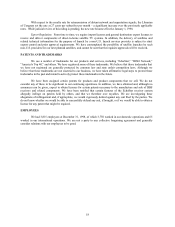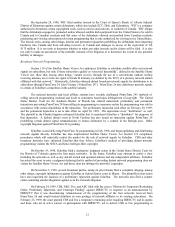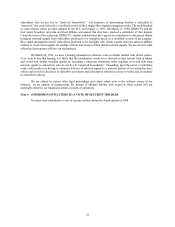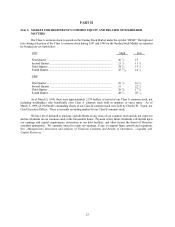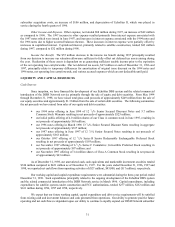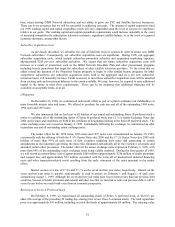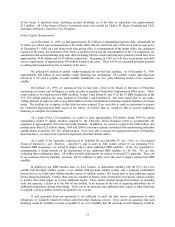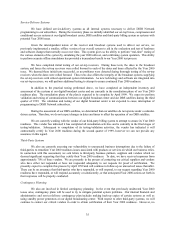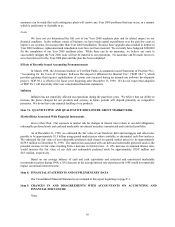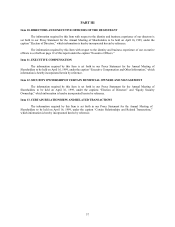Dish Network 1998 Annual Report Download - page 30
Download and view the complete annual report
Please find page 30 of the 1998 Dish Network annual report below. You can navigate through the pages in the report by either clicking on the pages listed below, or by using the keyword search tool below to find specific information within the annual report.28
with the increase in DTH equipment revenue. Cost of sales – DTH equipment and integration services principally
includes costs associated with digital set-top boxes and related components sold to international DTH operators. As a
percentage of DTH equipment revenue, cost of sales represented 68% during each of 1998 and 1997. We expect that
cost of sales may increase as a percentage of DTH equipment revenue in the future, due to price pressure resulting from
increased competition from other providers of DTH equipment.
Marketing Expenses. Marketing expenses totaled $321 million during 1998, an increase of $141 million or
78%, compared to 1997. The increase in marketing expenses was primarily attributable to the increase in subscriber
promotion subsidies. Subscriber promotion subsidies include the excess of transaction costs over transaction proceeds
at the time of sale of EchoStar receiver systems, activation allowances paid to retailers, and other promotional
incentives. During all of 1998 we recognized subscriber promotion subsidies as incurred. These expenses totaled
$273 million during 1998, an increase of $128 million over 1997. This increase resulted from increased subscriber
activations and the immediate recognition of all subscriber promotion subsidies incurred in 1998, due to the removal of
any prepaid subscription requirement. During 1997, a portion of such expenses were initially deferred and amortized
over the related prepaid subscription term, generally one year. Advertising and other expenses totaled $48 million
during 1998, an increase of $13 million over 1997.
During 1998, our subscriber acquisition costs, inclusive of acquisition marketing expenses, totaled
$314 million, or approximately $285 per new subscriber activation. Comparatively, our 1997 subscriber acquisition
costs, inclusive of acquisition marketing expenses and deferred subscriber acquisition costs, totaled $252 million, or
approximately $340 per new subscriber activation. The decrease in our subscriber acquisition costs, on a per new
subscriber activation basis, principally resulted from decreases in the manufactured cost of EchoStar receiver systems.
We expect that our subscriber acquisition costs, on a per new subscriber activation basis, will increase in the near-term
as we introduce aggressive marketing promotions to acquire new subscribers. For example, during 1999 we
introduced the PrimeStar bounty program. Our subscriber acquisition costs under this program are significantly
higher than those under our other marketing programs. To the extent that we either extend the duration of the
PrimeStar bounty program or begin to offer similar bounty programs for other competitors’ subscribers, our
subscriber acquisition costs, both in the aggregate and on a per new subscriber activation basis, will materially
increase.
General and Administrative Expenses. General and administrative expenses totaled $97 million during 1998,
an increase of $28 million as compared to 1997. The increase in G&A expenses was principally attributable to
increased personnel expenses to support the growth of the DISH Network. G&A expenses as a percentage of total
revenue decreased to 10% during 1998 compared to 15% during 1997. Although we expect that G&A expenses as a
percentage of total revenue will approximate 1998 levels or decline modestly in the future, this expense to revenue ratio
could increase.
Earnings Before Interest, Taxes, Depreciation and Amortization (“EBITDA”). EBITDA was negative $20
million and negative $51 million, during 1998 and 1997, respectively. EBITDA, as adjusted to exclude amortization of
subscriber acquisition costs, was negative $39 million for 1998 compared to negative $173 million for 1997. This
improvement in EBITDA principally resulted from increases in our ETC and DISH Network revenues. We believe our
ability to repay our existing debt will be significantly influenced by our ability to continue to improve reported
EBITDA. However, EBITDA does not purport to represent cash provided or used by operating activities and should
not be considered in isolation or as a substitute for measures of performance prepared in accordance with generally
accepted accounting principles.
During the fourth quarter of 1998, we introduced the DISH Network One-Rate Plan. Under the DISH
Network One-Rate Plan, consumers are eligible to receive a rebate of up to $299 on the purchase of certain EchoStar
receiver systems. Consequently, the costs of acquiring subscribers who qualify for the DISH Network One-Rate Plan
are materially higher than for other DISH Network subscribers. The rebate is contingent upon the subscriber’s one-
year commitment to subscribe to the America’s Top 100 CD programming package and two premium channel
packages, committing the subscriber to a monthly programming payment of at least $48.98. The consumer must pay
the entire sales price of the system at the time of purchase, but is not required to prepay for the programming. After
receiving the subscriber’s first full programming payment (equal to $97.96 for two months of programming), we issue
a rebate of up to $299 to the subscriber. Although subscriber acquisition costs are materially higher under the DISH
Network One-Rate Plan, we believe that these customers are more profitable because of the higher average revenue per


